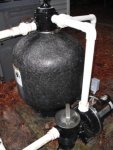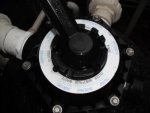- May 17, 2010
- 5
OK, I admit it -- I've had this inground pool for almost 15 years and have never had to do anything but sunbathe until now. Some friends helped me get the pool open a couple of weeks ago and now the real maintenance begins.
I know about chlorine tablets, skimmer baskets, and the vacuum-thingy. But here's my real problem: my filter's pressure gauge starts on about 5 and quickly drops to 0. A lot of air comes out of the water returns (is that what they're called?) and the advice I've gotten from another pool owner is that the sand probably needs to be replaced.
I've enlisted a willing helper but I can't find any information on the filter tank. It's about the size of a 55-gallon drum but has no manufacturer's information on it and I don't have a service manual. I know from your forum that I need to be sure to get "pool filter" sand but how much should I buy? One person said to get a 40-pound bag and another one told me to get (3) 50-pound bags. That's quite a spread!
Please give me advice on what to buy, how much to buy and any information you can provide on how to change the sand.
Oh, also it appears that the gasket around the top of the filter tank may need to be replaced. Where can I buy gaskets for a filter? How do I know what size to get? Thank you, thank you, thank you for any help you can provide!
SallieMander
I know about chlorine tablets, skimmer baskets, and the vacuum-thingy. But here's my real problem: my filter's pressure gauge starts on about 5 and quickly drops to 0. A lot of air comes out of the water returns (is that what they're called?) and the advice I've gotten from another pool owner is that the sand probably needs to be replaced.
I've enlisted a willing helper but I can't find any information on the filter tank. It's about the size of a 55-gallon drum but has no manufacturer's information on it and I don't have a service manual. I know from your forum that I need to be sure to get "pool filter" sand but how much should I buy? One person said to get a 40-pound bag and another one told me to get (3) 50-pound bags. That's quite a spread!
Please give me advice on what to buy, how much to buy and any information you can provide on how to change the sand.
Oh, also it appears that the gasket around the top of the filter tank may need to be replaced. Where can I buy gaskets for a filter? How do I know what size to get? Thank you, thank you, thank you for any help you can provide!
SallieMander





